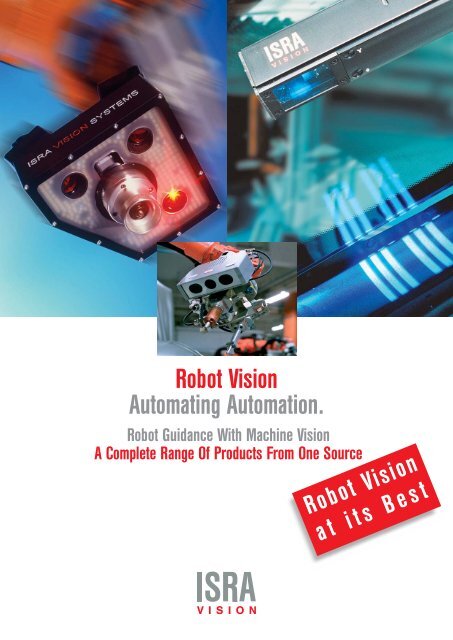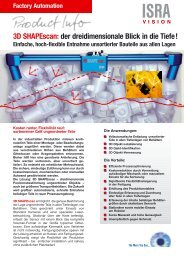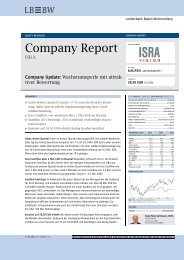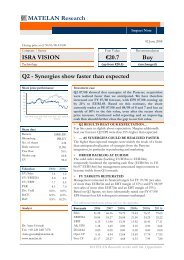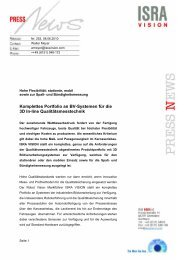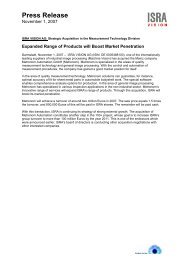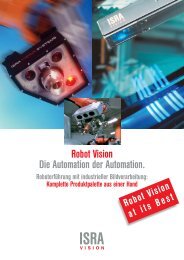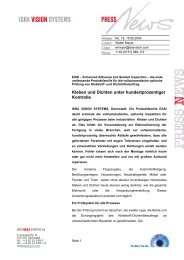Robot Vision automation - ISRA VISION AG
Robot Vision automation - ISRA VISION AG
Robot Vision automation - ISRA VISION AG
You also want an ePaper? Increase the reach of your titles
YUMPU automatically turns print PDFs into web optimized ePapers that Google loves.
<strong>Robot</strong> <strong>Vision</strong><br />
Automating Automation.<br />
<strong>Robot</strong> Guidance With Machine <strong>Vision</strong><br />
A Complete Range Of Products From One Source<br />
<strong>Robot</strong> <strong>Vision</strong><br />
at its Best
The Optimal Solution for Every Demand<br />
The World of <strong>Robot</strong> <strong>Vision</strong><br />
The demands on <strong>Robot</strong> <strong>Vision</strong> Systems start at the two-dimensional<br />
recognition of the translation and rotation of an object on<br />
a conveyor belt and extend beyond container unloading, to the<br />
recognition of all 6 degrees of freedom of the position of a moving<br />
object in space.<br />
Applications for 2D <strong>Robot</strong> <strong>Vision</strong>:<br />
• Loading and unloading presses<br />
• Loading and unloading processing machines<br />
• Sorting from the conveyor belt<br />
• Loading and unloading latticed boxes<br />
• Filling barrels<br />
• Commissioning pallets and containers<br />
• Controlling sanding and milling robots<br />
• Guiding filleting machines<br />
• Controlling labeling and marking systems<br />
• Controlling packaging machines<br />
• Positioning Pick & Place systems<br />
• Controlling flame impingement robots<br />
• Guiding slaughtering machines<br />
• Controlling riveting robots<br />
• Guiding harvesting machines<br />
The Optimal Solution for Every Branch<br />
Based on the complete portfolio of technologies, systems, products<br />
and components, as well as project experience from various<br />
branches, we are expanding our portfolio continuously in<br />
order to meet the branch-specific demands of our customers.<br />
Applications for 3D <strong>Robot</strong> <strong>Vision</strong>:<br />
• Controlling painting robots<br />
• Mounting glass, roofs, front modules, cockpits, etc.<br />
• Controlling the application of seams, sealant and adhesive<br />
• Controlling loading cranes<br />
• Loading and unloading racks<br />
• Loading and unloading boxes<br />
• Filling the tanks of stationary and moving vehicles<br />
• Mounting wheels on stationary and moving vehicles<br />
• Seam tracking in welding, gluing and sealing processes<br />
• Controlling laser cutting robots<br />
• Spatial collision monitoring<br />
• Controlling the stamping process<br />
• Loading and unloading baggage<br />
• Guiding milking and shearing robots<br />
• Controlling harvesting machines
Cutting-Edge Technology for Automation<br />
Machine <strong>Vision</strong> gives robots intelligent eyes. Using these eyes,<br />
robots can recognize the position of objects in space and adjust<br />
their working steps accordingly.<br />
Our constant goal as the market leader of <strong>Robot</strong> <strong>Vision</strong> is to<br />
design systems for automating <strong>automation</strong> - everything from<br />
simple pick & place applications to complex 3D tasks - and<br />
implement these cost-effectively. Our technological expertise,<br />
our experience and our innovative components support the<br />
cost-effective production of our customers worldwide.<br />
Core Competencies from the Start<br />
Since the company was founded in 1985, the technology of<br />
robot guidance has been one of <strong>ISRA</strong>'s core competencies.<br />
Time and again, we are setting a new course for the global market<br />
with innovative developments. One of the primary reasons<br />
for this is our longtime combination of expertise in <strong>Robot</strong>ics and<br />
Machine <strong>Vision</strong>.<br />
Today, industrial robots have become a major economic factor<br />
in industrial <strong>automation</strong>. With <strong>Robot</strong> <strong>Vision</strong>, the number of application<br />
possibilities for these <strong>automation</strong> components increases<br />
exponentially.<br />
Innovative Power for Customer´s Benefit<br />
Since the beginning, <strong>ISRA</strong> has aspired to regularly introduce<br />
new processes and applications to the market by means of systematic<br />
development of our know-how, thereby contributing to<br />
cost-effective production. Therefore, we regularly invest a large<br />
percentage of our turnover in Research & Development. The<br />
specialists in the <strong>ISRA</strong> R&D team make use of dedicated knowledge<br />
in the fields of optics, hardware and software development,<br />
lighting technology, engineering, numerics, algorithms,<br />
precision mechanics and sensor construction when developing<br />
highly complex <strong>Robot</strong> <strong>Vision</strong> Systems. In doing so, the team<br />
works closely with the applications and in close cooperation<br />
with our customers.<br />
<strong>Robot</strong> <strong>Vision</strong> Basics, from the Technology to the System<br />
Machine <strong>Vision</strong> for robot guidance provides the robot or handling<br />
system with information of where the component to be<br />
processed or moved is located spatially. This way, it is possible<br />
to automate handling, assembly and processing without having<br />
to precisely position and fix the components. This saves precious<br />
cycle time in production and reduces costs significantly.<br />
<strong>ISRA</strong> <strong>Robot</strong> <strong>Vision</strong><br />
<strong>Robot</strong> <strong>Vision</strong> is comprised of the following technologies :<br />
• Contrasting of all relevant optical features of the component<br />
with illumination and image acquisition technology that is<br />
optimal for the application<br />
• Fast and precise position determination of points, features or<br />
bodies in the plane or space using robust algorithms<br />
• Coordinate transformations between the coordinate systems<br />
of the camera, the robot, the object and the cell, and the<br />
calibration of the entire system<br />
• Time-efficient communication, resistant to transmission errors,<br />
between the image processor and the robot via various<br />
interfaces and protocols<br />
• Integration of additional procedures for quality measurement<br />
and inspection including the documentation of all relevant<br />
results.<br />
• Clear structuring of the software and concise user-interface<br />
in order to make complex technology available in a simple<br />
manner<br />
The Entire Equipment from One Source<br />
<strong>Robot</strong> <strong>Vision</strong> Systems are an integral part of production technology.<br />
Without a sound functioning system, the process comes to<br />
a halt. The demands on the availability of these systems are correspondingly<br />
high. The fact that all core components of the system<br />
come from one source is another reason why <strong>ISRA</strong> systems<br />
can guarantee a high degree of availability with low<br />
demands on maintenance and robust measuring and inspection<br />
results.<br />
<strong>Robot</strong> <strong>Vision</strong> Core Components<br />
• High-performance Frame Grabbers developed by <strong>ISRA</strong>,<br />
hardware-supported, fast processing with integrated FPGAs<br />
• Sensors optimal for the application from the robot-suited<br />
miniature camera, to stereo sensors and 3D form matching<br />
sensors, to sensors for the combination of robot guidance and<br />
quality inspection<br />
• Application know-how in the entire process, implemented in<br />
high-performance, robust and easy-to-use software with the<br />
components: calibration, measuring, inspecting, communication,<br />
data archiving and user support
<strong>Robot</strong> Guidance and Gauging Combined<br />
The family of <strong>Robot</strong> Guidance Sensors (RGS) can be<br />
implemented as either stationary or mobile<br />
(attached to the robot) 2D/3D position and coordinate<br />
measurement system. For very complex<br />
tasks, several sensors can be combined in a<br />
multi-sensor system. All sensors are calibrated<br />
internally and temperature compensated. The<br />
sensors are used for 3D robot guidance and<br />
seam tracking, for assembly tasks, for best-fit<br />
installation, and integrated quality measurements,<br />
including inline measurements.<br />
Compact – Robust – Economical<br />
Cameras and lighting units integrated on the robot or<br />
in the gripper are subject to intense stresses. The<br />
components must be compact, quick to assemble<br />
and reproducible for replacing and must be<br />
able to withstand high accelerations and strong<br />
vibrations. As to cameras, <strong>ISRA</strong> relies on tested<br />
standard components that are integrated in<br />
<strong>ISRA</strong>'s own robot-suited housings. LED lighting<br />
modules have been developed and produced<br />
in-house in order to obtain the optimal contrast<br />
in every application.<br />
Two Eyes for the Three-Dimensional World<br />
Spatial vision with stereo sensors works accor -<br />
ding to the same principle as the human eye.<br />
<strong>ISRA</strong>'s LOCMES (Location Measurement Sensor)<br />
determines the 3D coordinates of a point in<br />
space using two camera images. LOCMES registers<br />
objects that can be described using distinctive<br />
points, corners, lines or polynomial-like<br />
web contours. For definite measurements on<br />
areas, additional stripe light projectors are used.<br />
For large objects or increased accuracy, several<br />
LOCMES sensors are integrated in one network.<br />
3D Multi-Function Sensor:<br />
Guidance and Inspection<br />
Want 3D determination of the position and orientation<br />
of objects while simultaneously carrying<br />
out a fully automatic inspection of adhesive and<br />
sealant applications during the application<br />
process itself? With EASI3D, the functionalities for<br />
both tasks are integrated into one sensor head.<br />
This makes it possible to control and monitor the<br />
entire process of fully automatic adhesive and<br />
sealant application using only one sensor.<br />
<strong>Robot</strong> <strong>Vision</strong> Sensor Innovations<br />
RGS Features:<br />
• Multi-line 3D form matching<br />
• LED projection technology<br />
• Integrated LED area illumination, controllable<br />
power and adjustable intensity<br />
• Stationary and mobile use<br />
• Complete sensor family for various working<br />
distances<br />
<strong>Robot</strong> Camera Features:<br />
• Compact construction<br />
• Fast assembly and exchange<br />
• Miniaturized, robust case<br />
• Own power LED lighting units<br />
Stereo Sensor Features:<br />
• Stereo sensor with integrated stripe light<br />
projection<br />
• Freely configurable sensor arrangement<br />
• Stationary and mobile use<br />
• One sensor for various working distances<br />
EASI3D Features:<br />
• 3D position determination using stereometry<br />
• Integrated stripe light projector<br />
• 360° inspection within the application area<br />
around the nozzle<br />
• Adhesive and sealant inspection while<br />
in motion during the application, without<br />
reorienting the sensor in curves.
2D Position Recognition and Identification<br />
on the Plane<br />
The 2D <strong>Robot</strong> <strong>Vision</strong> System is the standard system<br />
for identification and position recognition. It<br />
provides information about the position, rotation,<br />
and component type that are arranged on a<br />
defined plane. The system distinguishes itself<br />
from others through its extreme speed. Contour<br />
extraction – accurate down to the subpixel – provides<br />
the highest precision, even in the case of<br />
fluctuating features. Applications for the system<br />
include de-palletizing from the running conveyor<br />
belt, sorting and removing objects from the belt,<br />
loading and unloading machines, and much<br />
more.<br />
2 1/2D Position and Orientation Recognition<br />
The 2 1/2D <strong>Robot</strong> <strong>Vision</strong> System provides information<br />
about the height of the object in addition<br />
to the position and rotation. Here the configurable<br />
scaling comes into play. Tasks such as de-palletizing<br />
or automatically unloading latticed boxes<br />
can be solved economically by the lean system<br />
construction. A sorting scheme and impact control<br />
inspection can be specified.<br />
3D Photogrammetry<br />
The system links the information from several<br />
cameras photogrammetrically to produce precise<br />
recognition of the object's spatial orientation.<br />
Deviations from a given target orientation are precisely<br />
calculated in all six degrees of freedom<br />
and robots, in particular, those that process large<br />
format components, such as the robots in an<br />
automobile painting line, are controlled.<br />
3 Dimensional <strong>Vision</strong> with One Camera<br />
MONO3D is the economical alternative to procedures<br />
and equipment for 3D measurements with<br />
two or more cameras. With one camera and one<br />
image only, all six degrees of freedom (position<br />
and orientation) can be determined precisely for<br />
a three-dimensional object using only three features.<br />
This can be used, for instance, for de-racking<br />
of complex components from transport and<br />
storage racks.<br />
<strong>ISRA</strong> <strong>Robot</strong> <strong>Vision</strong><br />
2D <strong>Robot</strong> <strong>Vision</strong><br />
Features of the 2D<br />
and 2 1/2D <strong>Robot</strong> <strong>Vision</strong> System:<br />
• Subpixel accuracy<br />
• Contour-based recognition<br />
• Independent of scaling<br />
• Integrated impact control<br />
• Robust against contrast fluctuations,<br />
size fluctuations, rotation and distortion<br />
2 1/2D <strong>Robot</strong> <strong>Vision</strong><br />
Features of Photogrammetry:<br />
• High accuracy, even with large components<br />
• All camera arrangements possible<br />
• Low amount of configuration work<br />
• Color-independent<br />
• Short measurement times<br />
3D <strong>Robot</strong> <strong>Vision</strong> Photogrammetry<br />
Features of MONO3D:<br />
• Reduced hardware use<br />
• High flexibility<br />
• High cost-effectiveness<br />
• Quick integration<br />
• Position determination, even while moving<br />
Monocular 3D <strong>Robot</strong> <strong>Vision</strong>
Features Stereo Measurement Technology:<br />
• Scaleable measurement volumes and measurement<br />
distances while using the same sensors<br />
• Feature and surface detection<br />
• High measurement distances<br />
3D Stereosystem<br />
Features Multi-Line 3D Form Matching<br />
• High measurement accuracy<br />
• Simultaneous registration of position<br />
and coordinates<br />
• Very short measurement cycles<br />
• Multi-sensor system and<br />
multi-tasking system<br />
3D Form Matching<br />
Features Visual Servo:<br />
• 3D in-line tracking<br />
• Optical conveyor synchronization<br />
• Adaptive track corrections during<br />
the running process<br />
Visual Servo<br />
Features AURA:<br />
• Learning system<br />
• Simple and quick set up<br />
• Adjustable to various image features<br />
and shapes<br />
• No calibration targets<br />
AURA<br />
The Art of <strong>Robot</strong> <strong>Vision</strong><br />
3D Stereo Measurement Technology<br />
3D Stereo Measurement Technology is used<br />
where the quality and efficiency of highly automated<br />
robots and handling systems can be<br />
increased through quick and precise position<br />
determination, for example, in processes for<br />
mounting glass, roofs, cockpits, etc. The systems<br />
can be stationary or mobile and can, depending<br />
on the demands, control any number of stereo<br />
sensors in a network.<br />
3D Form Matching – <strong>Robot</strong> Guidance<br />
& In-Line Measurement Technology<br />
The use of multi-line projection sensors with integrated<br />
area illumination allows for the combination<br />
of 2D/3D robot guidance and 2D/3D in-line<br />
measurement technology. The high level of<br />
redundancy of the measurement lines ensures<br />
robust and precise measurement results. The<br />
systems can be stationary or mobile. Assembly<br />
processes with simultaneous coordinate measurement<br />
technology for quality inspections are<br />
automated with these systems.<br />
Visual Servo and Seam Tracking<br />
Visual Servoing describes the conveyor synchronization<br />
of the robot using the 3D vision system.<br />
This enables processing and assembly processes<br />
to take place during component feed, for<br />
example, wheel assembly or the filling of the gas<br />
tank on a moving vehicle.<br />
In seam tracking, the robot is moved exactly<br />
along the component geometry; for instance for<br />
the precise sealing of seams that do not run in a<br />
straight line.<br />
Learning <strong>Robot</strong> Guidance<br />
AURA (Adapted Uncalibrated <strong>Robot</strong> Automation)<br />
is a new method for 3D robot guidance. The procedure<br />
is distinguished by its automatic learning<br />
ability at various robot positions. Calibration of the<br />
cameras is not necessary.
<strong>Robot</strong> <strong>Vision</strong> Software – Coded Application Know-How<br />
Our experience from hundreds of <strong>Robot</strong> <strong>Vision</strong> projects<br />
worldwide and in various fields of application manifests itself<br />
in the software for our systems. That is what we at <strong>ISRA</strong> call<br />
Brainware.<br />
Calibration<br />
The systems provide all the classic calibration methods, and<br />
some innovative ones, too. Depending on the application<br />
and surrounding conditions, you can choose between fully<br />
automated calibration with a fixed or moving calibration<br />
plate, calibration without the calibration plate, or uncalibrated<br />
self-learning operation.<br />
Position Determination<br />
Contrast-oriented, feature-oriented, contour-oriented or projection-oriented<br />
algorithms are used to recognize the features<br />
for determining the position of the component.<br />
Photogrammetrical, stereo-based and 3D form matchingbased<br />
calculations of all 6 degrees of freedom of the<br />
object's position are available.<br />
Reliability<br />
The large number of processes employed guarantee the<br />
feature recognition at a high degree of reliability. All<br />
processes work redundantly, offer automatic alternative<br />
strategies and allow manual correction in emergencies.<br />
Every measurement is subject to a quality inspection and a<br />
plausibility inspection before it is used to control the robot.<br />
All results are documented and archived.<br />
<strong>Robot</strong> <strong>Vision</strong> Brainware<br />
High Levels of Clarity:<br />
• Structured, ergonomic layout<br />
• User-interface can be customized flexibly<br />
• Context-sensitive, clear user-operation<br />
• Image-oriented overview display with the presentation<br />
• All production-relevant data for the<br />
current component<br />
• Understandable, user-oriented nomenclature<br />
Direct Diagnosis:<br />
• Display of the system status using colored<br />
status light signals<br />
• Extensive logging area<br />
• Overview image with graphical visualization<br />
of all measurement features and their status<br />
High Flexibility:<br />
• Quick teach-in<br />
• Point, edge and surface detection<br />
• Automated self-control<br />
• Automatic and manual compensation<br />
strategies
World class <strong>automation</strong><br />
<strong>ISRA</strong> <strong>VISION</strong> has been a leading supplier of high-performance<br />
quality inspection, robot guidance and production logistics systems<br />
for more than 20 years.<br />
These systems are used all over the world in such industries as<br />
automotive, tier 1 automotive suppliers, packaging, aerospace, food,<br />
logistics, mechanical & plant engineering, and robotics.<br />
Our goal is to offer a complete portfolio of standard solutions which<br />
meet the full spectrum of requirements along the entire process<br />
chain.<br />
Thousands of successful installations worldwide demonstrate<br />
<strong>ISRA</strong>’s experience and technological expertise in machine vision.<br />
<strong>ISRA</strong> <strong>VISION</strong><br />
Germany<br />
Tel. : +49 (6151) 948-0<br />
Fax: +49 (6151) 948-140<br />
UK<br />
Tel. : +44 (1322) 520410<br />
Fax: +44 (1322) 559419<br />
Turkey<br />
Tel. : +90 (216) 688 1015<br />
Fax: +90 (216) 688 1016<br />
Spain<br />
Tel. : +34 (93) 589 71 79<br />
Fax: +34 (93) 589 71 79<br />
Italy<br />
Tel. : +39 (0464) 490 603<br />
Fax: +39 (0464) 498 875<br />
France<br />
Tel. : +33 (4) 7211 4067<br />
Fax: +33 (4) 7211 4068<br />
Belgium<br />
Tel. : +32 (2) 6523-866<br />
Fax: +32 (2) 6523-728<br />
Ireland<br />
Tel.: +353 (61) 748411<br />
Fax: +353 (61) 748411<br />
Innovations for <strong>Robot</strong> Automation<br />
USA<br />
Tel.: +1 (248) 499-6468<br />
Fax: +1 (248) 499-6463<br />
Brazil<br />
Tel. : +55 (11) 3476-1132<br />
Fax: +55 (11) 3476-1132<br />
Optimize your ROI - with the technology leader <strong>ISRA</strong><br />
www.isravision.com<br />
A summary of the advantages<br />
Customers choose <strong>ISRA</strong> over the competition for the following<br />
reasons:<br />
• Our development activities are fully focused on the needs of<br />
our customers.<br />
• We consistently invest in our own know-how in all of the core<br />
areas of machine vision.<br />
• At our company, the customer relationship does not end when<br />
a new system leaves our shipping dock. The Customer Support<br />
Center operates a range of services including a telephone hotline,<br />
teleservice, on-site service and maintenance to support our customers<br />
during operation of their systems and equipment and to<br />
help them increase their productivity.<br />
• More than 400 team members at our locations in Europe, the<br />
Americas and Asia are committed to helping you achieve<br />
success.<br />
P.R. China<br />
Tel.: +86 (21) 6891 6286-0<br />
Fax: +86 (21) 6891 6286-888<br />
Korea<br />
Tel.: +82 (2) 790-1326<br />
Fax: +82 (2) 790-1329<br />
The More You See...<br />
Japan<br />
Tel.: +81 (3) 3253-5771<br />
Fax: +81 (3) 3253-5772<br />
Taiwan (R.O.C.)<br />
Tel. : +886 (3) 2500-148<br />
Fax: +886 (3) 2500-149


